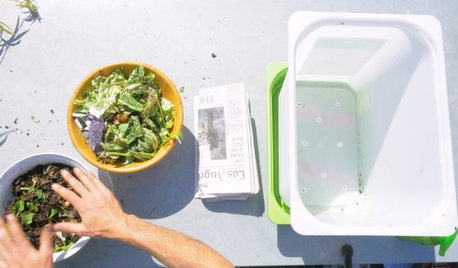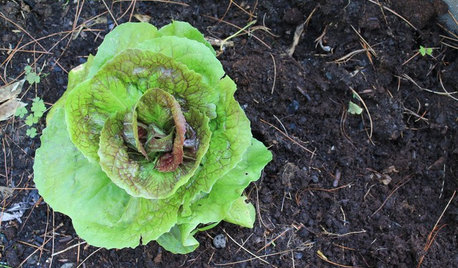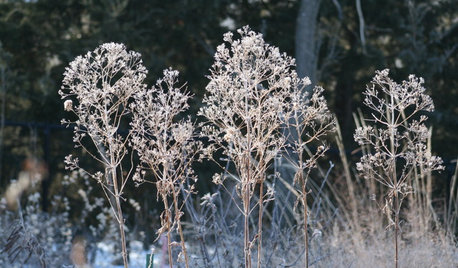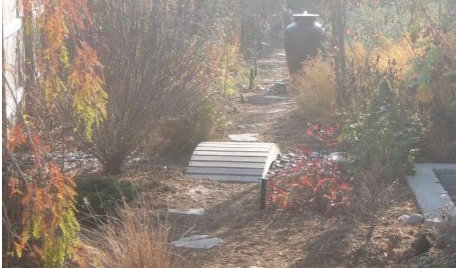Can I feed my worms Sourdough starter?
Djauregui1
13 years ago
Featured Answer
Sort by:Oldest
Comments (6)
borderbarb
13 years agoRelated Discussions
About my 2 sourdough starters...
Comments (4)Spread some on plastic or parchment paper or something. It will dry up and then you can store it. It's kind of the way that they save commercial yeast in the packages - remember that almost all of the yeast cells in the package are dead. I don't remember the exact difference between the rapid rise that came out about 50 years ago and the newer instant rise - if I'm not mistaken one of the main differences is that the newer one has more live yeast cells. As some cells die they entomb a live cell, so you have these little balls of dead cells surrounding a live one and consequently you have a greater proportion of viable cells when you start. The labeling isn't consistent, which is a pain. The vendor can call it whatever he wants But the earlier yeast, whatever it's called, is dried at higher temperatures. That kills more of the exterior yeast cells. The newer one, instant or rapid or whatever, is dried at lower temperatures so more cells survive. So you can do the same. However, at some point that yeast will no longer be viable either - all yeast has an expiration date eventually. Anyhow, good luck with that phase!...See MoreConfused with sourdough starter
Comments (7)Ginny, I am very familiar with Carl Griffith's 1847 Oregon Trail Sourdough culture. Mine has been going strong for 3-4 years now. Usually the starter is fed with equal measures of flour and filtered or bottled water. If you continue to feed it every 12 hours, you will end up with way more starter than you need. Following is from the information sheet that I provide when I share either of my starters: The starter will need feeding about every couple of weeks; just add 1 cup warm water and 1 cup flour. When you want to bake bread, take the starter out of the fridge and bring it up to room temperature (this will take 1-2 hours). Then, feed the starter with 1 cup flour and 1 cup warm water and let it sit in a warm place overnight to ferment. The next morning, remove the amount you need for baking. Pour the remaining starter into a clean jar and refrigerate. Wash the previous jar very well. I have only fed my starter with water and flour, no milk, no potato flakes or potato water and only used sugar and the potato flakes at the very first to activate the dried starter. Beat some air into the starter with the spoon or fork as you feed it. If you find yourself with only a small amount of starter left, you will need to build the starter  i.e. donÂt dump a whole cup of flour and water into 2 TB of starter! To build your starter amount: add 1-2 TB of flour and water into a small amount of remaining starter, let sit to work; then add about 1/4cup flour and water, stir well, let sit to work; next feed, add another 1/4cup flour and water, stir well, let sit to work. Let the starter work for a minimum of 2 hours each time after you feed it. Now you have built up additional starter so you can feed with 1 cup each flour and water, let sit to work, use to make bread, or store in fridge. Store the starter in glass or crockery. I mix the bread in my Kitchen Aid stainless mixer and let it rise in the stainless bowl or in a crockery bowl. There is a lot of speculation about the sourness of bread. One idea is every once in awhile use dark rye flour to feed the starter or some in the bread dough. Another is to let it rise at a lower temperature (60?) so it rises longer and gives the bacteria a longer time to do their work. Some feel that making the starter more firm (adding more flour than water when feeding it) results in a more sour taste. DonÂt expect your starter to ever taste as sour as commercial sourdough bread  they add things to it to get that really sour taste. The starter will develop "hooch"  a mixture of alcohol and water  while being stored in the refrigerator. If there is more than one-inch of hooch, I pour most of that off, let the starter come to room temp, feed it, let it expand 4 hours, then use it to make bread or put back in the refrigerator. Any sourdough recipe you may try assumes that the starter has been fed and left to rise, then you begin the recipe. Hope this helps, Teresa...See MoreSourdough starter is a non-starter
Comments (20)I'm glad I posted this -- I'm learning all sorts of things! I didn't realize that sourdough isn't necessarily sour -- but it makes sense the commerical stuff is more so. (I had a friend's homemade sourdough recently, and while it was a very nice bread I remember thinking it wasn't nearly sour enough!) The sour taste is really what I'm going for -- if I can't get that going naturally, I'll looking into adding the taste in with other things. (I picked up a littl container of buttermilk powder for another recipe -- that might be a good taste to play around with!) Thanks for the explanation on acidity and the viscosity of the starter, Carol; that's helps a lot. The alchemy of baking has always intimidated me -- it's good to have a clearer idea of what's going on. I'll keep plugging away for a while longer with this starter, perhaps feed it whole wheat for a while and see if that builds up it's puny flour-lifting muscles. If not, the soured yeast dough may be the way to go, jessica; I didn't know you could do that. It might actually be better way to go, given the infrequency with which I bake. I'm still going to work with this starter -- Ill keep you posted!...See MoreI was worried about my sourdough starter.
Comments (3)I bet it smells wonderful! I have some starter Teresa sent me months and months ago..I haven't really had time yet to babysit it and care for it as it should be, so I have yet to activate it. But soon I hope to....See Moretoxcrusadr
8 years agogorbelly
8 years agoMarta Nelson
4 years agolast modified: 4 years agopurslanegarden
4 years ago
Related Stories

GARDENING GUIDESHouzz TV: Make a Worm Bin for Rich Soil and Happy Plants
A worm-powered compost bin that can fit under a sink turns food scraps into a powerful amendment for your garden. Here’s how to make one
Full Story
GARDENING GUIDES4 Ways Gardens Can Go Beyond Aesthetic Beauty
Our landscapes can play an even more meaningful role if we rethink their purpose
Full Story
CONTAINER GARDENSYes, You Can Grow a Plant In That
You can upcycle your old typewriter, paint cans, tires and many more things into places for your plants
Full Story
FARM YOUR YARDHow to Get Good Soil for Your Edible Garden
The nutrients in your soil feed the plants that feed you. Here are tips on getting it right — just in time for planting season
Full Story
WINTER GARDENING10 Native Wildflowers to Beautify Your Winter Garden
They stand strong in wind, feed wildlife and are easy to grow. But you may want to add these plants for their looks alone
Full Story
GARDENING AND LANDSCAPINGTurn Household 'Junk' Into Garden Treasures
Don't kick discarded household items to the curb — send them to the garden as planters, art pieces and conversation starters
Full Story
WINTER GARDENING6 Reasons I’m Not Looking Forward to Spring
Not kicking up your heels anticipating rushes of spring color and garden catalogs? You’re not alone
Full Story
GARDENING GUIDESCentral Plains Gardener's November Checklist
Mulching, seeding, feeding — several small tasks to ensure a winter of activity, and a good spring start.
Full Story
MOST POPULARThe Perfect Houseplant for People Who Kill Houseplants
If you can fill a jar with water, you can keep golden pothos vine happy — and it will pay you back with cleaner air and a greener home
Full Story
FARM YOUR YARDRemake Your Backyard Into a Mini Farm
You can get a taste of country life by line-drying your laundry, growing some produce or going whole hog with the critters
Full Story




gorbelly